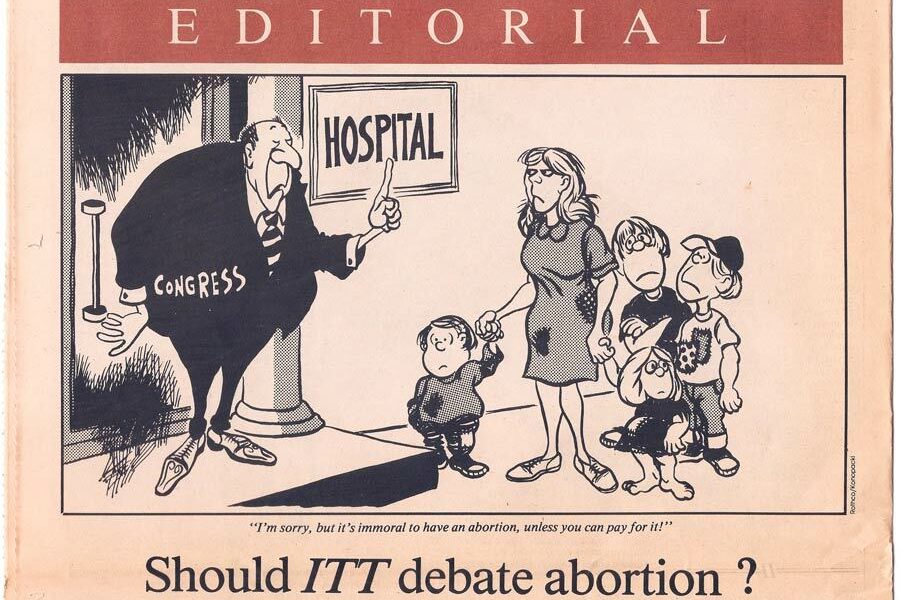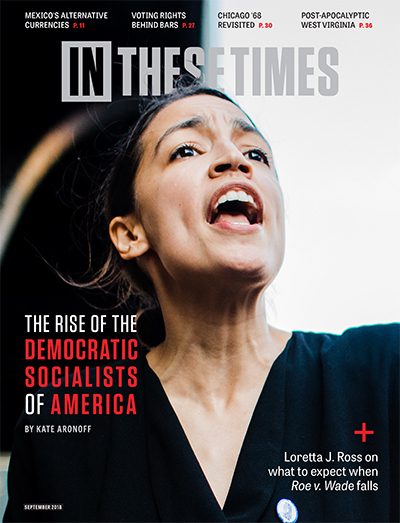Why Did We Run an Anti-Abortion Piece in 1979?
A look back at the historical context and where we went wrong.
Jessica Stites

In February 1979, In These Times published the debate, “Pro and Con: Does free abortion hurt the poor and minorities?” The then-newspaper was flooded with letters to the editor from a who’s who of feminists objecting to both the framing of the debate and its participants — Elizabeth Moore, a Catholic right-to-life advocate, and Karen Mulhauser, a leader of the National Abortion Rights Action League (NARAL).
The editorial decision-making process is lost to history, but this much we know: The Catholic Left held sway with ITT in the 1970s. A July 1977 editorial called for “serious dialogue with sincere ‘right-to-life’ advocates [who oppose abortion] out of genuine religious or moral concern for the sanctity of life.” ITT ran pieces by Juli Loesch, a major force in the Catholic “consistent life” movement, which wedded anti-nuclear, antiwar and anti-abortion politics. Loesch and other Catholic feminists were eventually pushed out of anti-abortion leadership by patriarchal evangelicals, who kept the Catholic leftists’ direct action tactics of clinic pickets and harassment, which escalated into murder.
Moore and Loesch were among the cofounders of Prolifers for Survival, inspired by the 1979 Three Mile Island disaster to “protect life by opposing nuclear proliferation and abortion.” But Moore preached to ITT readers in the language of economics, not religion, arguing that state-subsidized abortion was a scheme against welfare:
One of the most compelling arguments of the [abortion] funding advocates is that payment for a poor woman’s abortion is cheaper than live birth and subsequent AFDC [Aid to Families with Dependent Children] payments. It should come as no surprise that the poor become highly suspicious when basic necessities of life remain unattainable while unlimited abortion funds are offered as a solution to the “high cost” of welfare.
As evidence that eugenicism underlay these policies, Moore quoted the pro-abortion argument of syndicated columnist Harriet von Horne: “There are too many births … particularly to the disadvantaged and the genetically unfit. … [The country] truly cannot afford any more welfare babies.”
Some of the anti-Moore letters suggested that she was what the internet would now call a “concern troll” — one who pretends to be an ally voicing critique, but is actually a foe. The anti-abortion Right had already begun to develop the cynical racial rhetoric that would lead it to post billboards in Atlanta in the 2000s reading “Abortion is black genocide.” One of the 1979 letters to the editor, signed by Marilyn Katz and ten others, charges ITT with “[falling] prey to the new Right’s increasingly bold strategy of fraudulent ‘leftism’ and spurious ‘anti-racism.’ ”
It’s likely, however, that Moore was sincere. According to historian Jennifer Donnally, Moore clashed with the conservative wing of the antiabortion movement and argued that “feminists and others would best help women in crisis pregnancies by advocating for better welfare policies and healthcare.” (Such points of agreement had led NOW president Eleanor Smeal to call a peace summit in January 1979, but pro-life feminists refused to come unless all abortion clinics shut down operations for the day; a small contingent from Ohio did show up, and brandished the body of an aborted fetus.)
Concern troll or no, many of Moore’s criticisms hold water. They echo the arguments of National Welfare Rights Organization (NWRO) chairperson Johnnie Tillmon in her landmark 1971 Ms. magazine essay, “Welfare is a Women’s Issue”:
Welfare is like a super-sexist marriage. You trade in a man for the man. But you can’t divorce him if he treats you bad. He can divorce you, of course, cut you off anytime he wants. But in that case, he keeps the kids, not you. The man runs everything. In ordinary marriage, sex is supposed to be for your husband. On AFDC, you’re not supposed to have any sex at all. You give up control of your own body. It’s a condition of aid. You may even have to agree to get your tubes tied so you can never have more children just to avoid being cut off welfare.
Tillmon, like Moore, called out the eugenicism and classism of some white feminists and the myopia of their focus on abortion rights. Yet Moore’s conclusion — to oppose abortion — does not necessarily follow. Tillmon wrote, “Nobody realizes more than poor women that all women should have the right to control their own reproduction.”
According to historian Karissa Haugeberg, this was in line with working-class black women of the 1960s and 1970s: “Although some sought to make the link between eugenics, forced sterilization and state-financed abortions, many more understood how the state had historically sought to control women’s bodies through these mechanisms, and that legal abortion would enable women to make decisions of their own accord.” It would also presage the reproductive justice movement started by black feminists like Loretta J. Ross in the 1990s (see page 16), which sees abortion rights as part of broader reproductive self-determination.
If ITT wanted to know whether “the poor and minorities” were “hurt” by “free abortion,” we could have asked them. And, as Katz et al. noted, the socialist newspaper might have solicited “a socialist feminist perspective (which NARAL does not represent).” Apparently “it’s who you know, not what you know” holds in socialist as well as capitalist circles. The ITT of 1979 seems not to have been well-acquainted with the welfare rights movement — and to have inexplicably forgotten the phone number of ITT’s socialist-feminist founding sponsor Barbara Ehrenreich.
Jessica Stites is Editor-at-large for In These Times.









